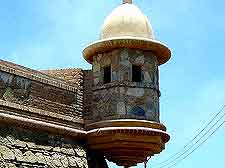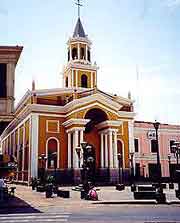Callao History Facts and Timeline
(Callao, Peru)

This lively port city may now be considered a wealthy residential suburb of Lima, but the history of Callao is rich and fascinating in its own right as the main port of the Viceroyalty of Peru.
Sea lions and birds frolic in natural unspoiled territory alongside this bustling port, the San Lorenzo military base and the high security prison containing former communist Shining Path organisation leader, Abimael Guzmán Reynoso. Callao is also home to the Jorge Chávez International Airport, situated roughly 16 km / 10 miles from Lima's historic city centre.
Earliest Residents
Unlike many other parts of Peru, none of the country's great empires prior to European settlement were ever based in Callao or nearby
Lima. The Pachacamac shrine was the most important landmark in this valley, where numerous cultures flourished.
The adobe Huaca Pucllana building in Lima's Miraflores district became the first permanent centre of the area's maritime culture. The Huari, the Ychma and the Inca all ruled the region at various points in the history of Callao, prior to Spanish settlement.
Founding of the Port
Only a couple of years after Spanish colonists established the settlement of Lima in 1535, Francisco Pizarro was responsible for the creation of the nearby port of Callao, which soon became Spain's most important Pacific Ocean port. Although the constant port traffic between Spain, Cuba, and the rest of South America brought much wealth to Callao, it also made the port a frequent target for pirates and invaders from other European nations. The most famous person to attack and plunder this city was none other than English sea captain, Sir Francis Drake, in the year of 1578.
Earthquake, Tsunami and Reconstruction
In 1746, a serious earthquake and subsequent tsunami severely damaged the original port of Callao, which was moved and rebuilt at a new location just over 1 km / 0.5 miles from its original site. The same Real Felipe fortress originally constructed to protect the new port eventually helped Peruvian revolutionaries in their battle for independence from Spain.

Peruvian Independence
Three years after revolutionary leader Simon Bolivar first entered the port in 1823, the Real Felipe fort became the site of Spanish surrender. After the Peru-Bolivian Confederacy was created in 1836, Callao and its surrounding area then became an independent province. In 1851, Callao and Lima became the two principal destinations along South America's first railroad.
Invasions, Earthquakes and Cocaine
A Spanish fleet bombed the port of Callao during their 1866 attempt to re-conquer Peru. The port then fell under Chilean forces during the 1881 War of the Pacific, before being returned to Peru in 1883.
In 1940, the port was once again destroyed by another devastating earthquake. Callao quickly recovered and soon developed an infamous reputation as one of the world's busiest cocaine trafficking hubs and producers.
History of the Modern City
Lima's rapid 20th-century population explosion expanded into Callao, until the two cities became part of a much bigger urban area.
Although many of the city's most historic buildings, like their counterparts in neighbouring Lima, are now dilapidated to the point of near collapse, they still manage to retain their original splendour from the era in the history of Callao when it was one of the world's most significant ports.
 This lively port city may now be considered a wealthy residential suburb of Lima, but the history of Callao is rich and fascinating in its own right as the main port of the Viceroyalty of Peru.
This lively port city may now be considered a wealthy residential suburb of Lima, but the history of Callao is rich and fascinating in its own right as the main port of the Viceroyalty of Peru.